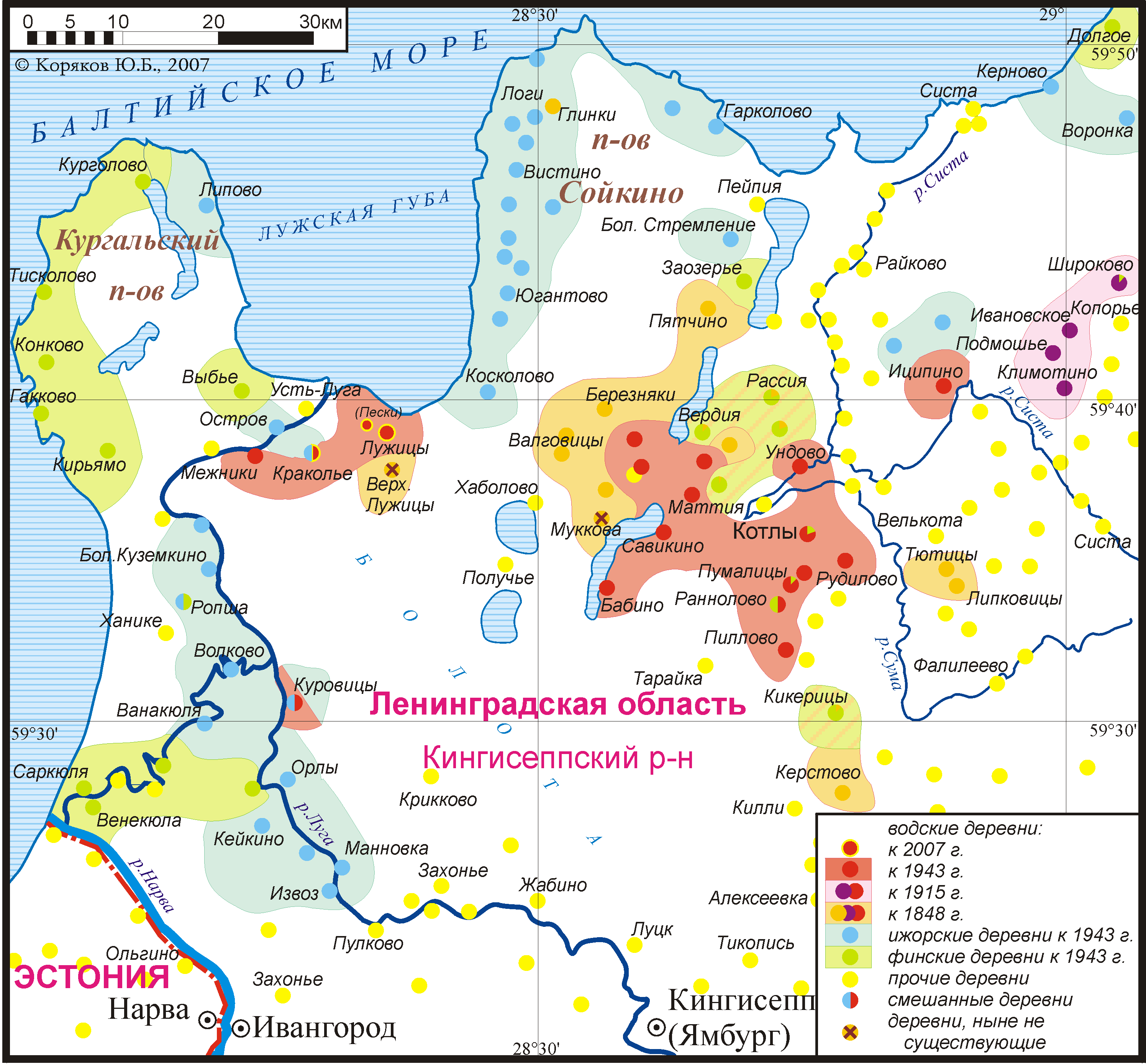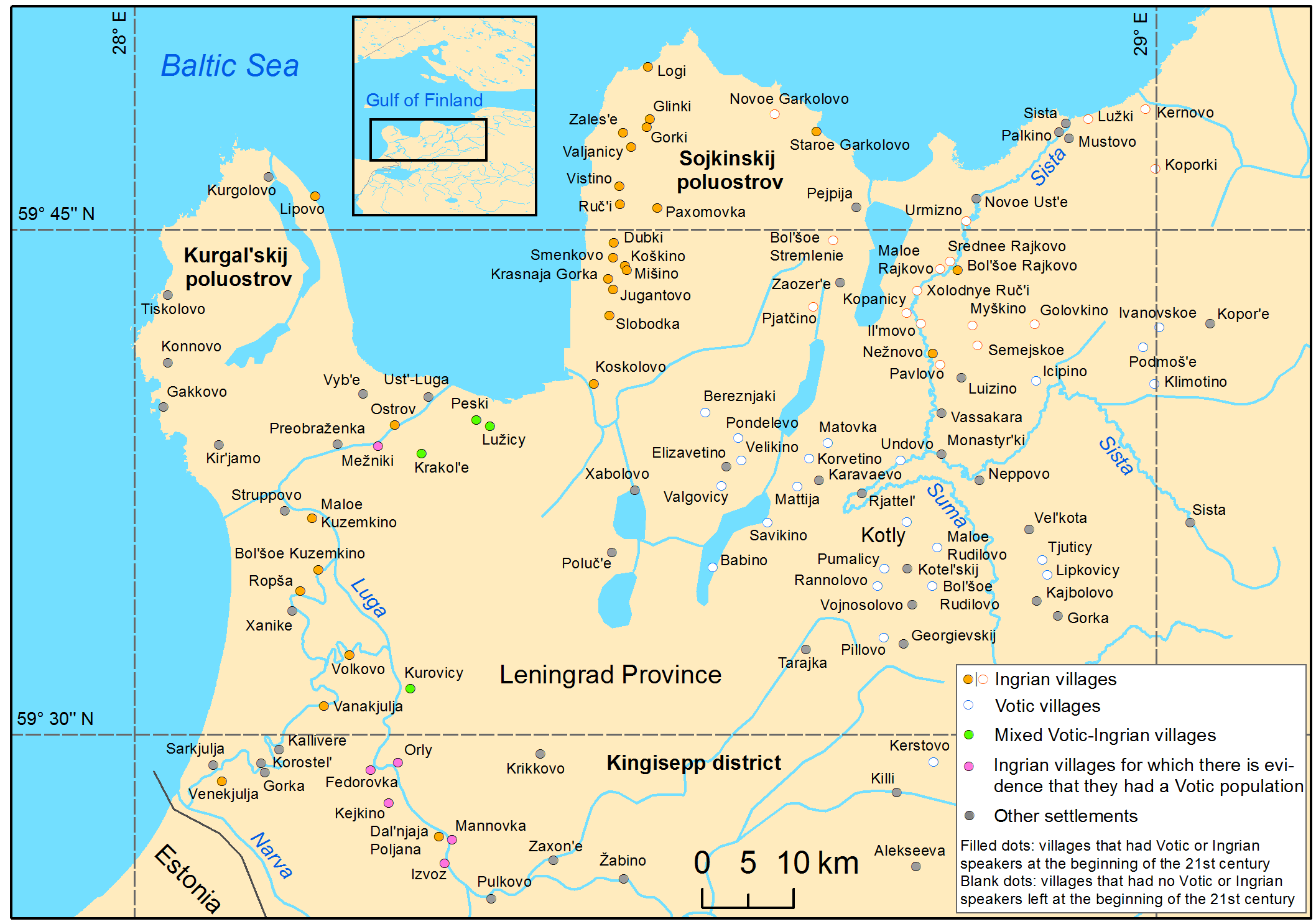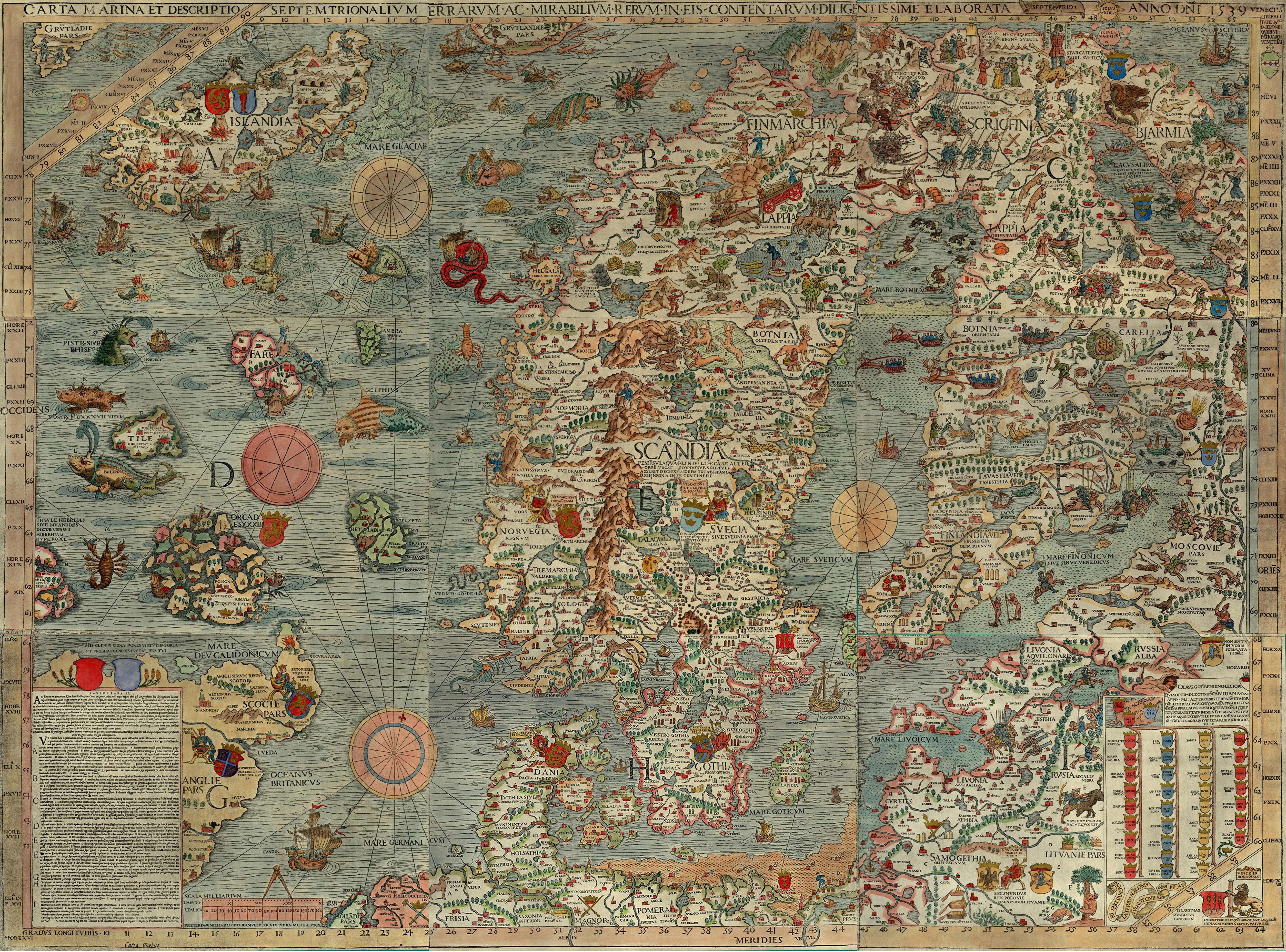|
Izhorians
The Izhorians (; ; ; ) are a Finnic indigenous people native to Ingria. Small numbers can still be found in the western part of Ingria, between the Narva and Neva rivers in northwestern Russia. They are also referred to as Ingrians, although the term can also refer to the Ingrian Finns or the Baltic Finnic residents of Ingria in general. History The history of the Izhorians is bound to the history of Ingria. It is supposed that shortly after 1000 AD the Izhorians moved from Karelia to the west and south-west. In 1478, the Novgorod Republic, where Ingrians had settled, was united with the Grand Duchy of Moscow, and some of the Izhorians were transferred to the east. The establishment of St Petersburg in 1703 had a great influence on Izhorian culture. World War II had the biggest impact on Izhorians, as devastating battles (such as the Siege of Leningrad) took place on their territory. In 1848, P. von Köppen counted 17,800 Izhorians, and by 1926 there were 26,137 Izhorians ... [...More Info...] [...Related Items...] OR: [Wikipedia] [Google] [Baidu] |
Ingrian Language
Ingrian (, ), also called Izhorian (, , ), is a Finnic language spoken by the (mainly Orthodox) Izhorians of Ingria. It has approximately 70 native speakers left, most of whom are elderly. The Ingrian language should be distinguished from the Ingrian dialect of the Finnish language, which became the majority language of Ingria in the 17th century with the influx of Lutheran Finnish immigrants; their descendants, the Ingrian Finns, are often referred to as Ingrians. The immigration of Lutheran Finns was promoted by Swedish authorities, who gained the area in 1617 from Russia, as the local population was (and remained) Orthodox. Dialects Four dialect groups of Ingrian have been attested, two of which are probably extinct by now: * Hevaha, spoken along Kovashi River and nearby coastal areas (†) * Soikkola, spoken on Soikinsky Peninsula and along Sista River * Ylä-Laukaa (Upper Luga or Oredezhi), spoken along Oredezh River and the upper Luga River (†) * Ala-Laukaa (Lo ... [...More Info...] [...Related Items...] OR: [Wikipedia] [Google] [Baidu] |
Ingria
Ingria (; ; ; ) is a historical region including, and adjacent to, what is now the city of Saint Petersburg in northwestern Russia. The region lies along the southeastern shore of the Gulf of Finland, bordered by Lake Ladoga on the Karelian Isthmus in the north and by the Narva river on the current international border with Estonia in the west. The earliest known inhabitants of the region were indigenous Finnic peoples, primarily the ancestors of modern Izhorians and Votians, who converted to Eastern Orthodox Christianity during the late Middle Ages. They were later joined by the Ingrian Finns, descendants of 17th century Lutheran Finnish immigrants. At that time, Ingria, the Karelian Isthmus, Estonia, and what is now Finland were all part of the Kingdom of Sweden. Ingria as a whole never formed a separate state; however, North Ingria was an independent state for just under two years in 1919–1920. The inhabitants of Ingria cannot be said to have comprised a distinct n ... [...More Info...] [...Related Items...] OR: [Wikipedia] [Google] [Baidu] |
Votians
Vots, also referred to as Votes, Vods and Votians (, ''vađđalaizõd''; ; ; ) are a Baltic Finns, Finnic ethnic group native to historical Ingria, the part of modern-day northwestern Russia that is roughly southwest of Saint Petersburg and east of the Estonian border-town of Narva. The Finnic languages, Finnic Votic language spoken by Vots is close to Language death, extinction. The language is still spoken in three villages of historical Votia and by an unknown number of speakers in the countryside. The villages are ''Jõgõperä'' (Krakolye), ''Liivcülä'' (Peski), and ''Luuditsa'' (Luzhitsy).Eesti Rahva Muuseum: Vadjalased Archived In the Russian 2020 ... [...More Info...] [...Related Items...] OR: [Wikipedia] [Google] [Baidu] |
Ingrian Finns
Ingrian Finns (, ; ) are the Finnish people, Finnish population of Ingria (now the central part of Leningrad Oblast in Russia), descending from Lutheranism, Lutheran Finnish immigrants introduced into the area in the 17th century, when Finland and Ingria were both parts of the Swedish Empire. Before and after World War II, most of them were relocated to other parts of the Soviet Union or killed, in Soviet campaigns directed towards their Deportations of the Ingrian Finns, forced deportation and Genocide of the Ingrian Finns, genocide. Today the Ingrian Finns constitute the largest part of the Finnish population of the Russian Federation. According to some records, some 25,000 Ingrian Finns have returned or still reside in the region of Saint Petersburg. They are also referred to as Ingrians, although the term can also refer to the Izhorians or the Baltic Finnic residents of Ingria in general. History Origins Ingrian Finns are the indigenous minority of Europe. Finnish-speakin ... [...More Info...] [...Related Items...] OR: [Wikipedia] [Google] [Baidu] |
Baltic Finns
The Baltic Finnic peoples, often simply referred to as the Finnic peoples, are the peoples inhabiting the Baltic Sea region in Northern and Eastern Europe who speak Finnic languages. They include the Finns, Estonians (including Võros and Setos), Karelians (including Ludes and Livvi), Veps, Izhorians, Votes, and Livonians. In some cases the Kvens, Ingrians, Tornedalians and speakers of Meänkieli are considered separate from the Finns. The bulk of the Finnic peoples (more than 98%) are ethnic Finns and Estonians, who reside in the two independent Finnic nation states—Finland and Estonia. Finnic peoples are also significant minority groups in neighbouring countries of Sweden, Norway and Russia, especially Karelia. Theories of origin According to the "Migration Theory" that was based primarily on comparative linguistics, the proto-Finns migrated from an ancient homeland somewhere in north-western Siberia or western Russia to the shores of the Baltic Sea around ... [...More Info...] [...Related Items...] OR: [Wikipedia] [Google] [Baidu] |
Karelians
Karelians (; ; ; ) are a Baltic Finnic ethnic group who are indigenous to the historical region of Karelia, which is today split between Finland and Russia. Karelians living in Russian Karelia are considered a distinct ethnic group closely related to Finnish Karelians, who are considered a subset of Finns. This distinction historically arose from Karelia having been fought over and eventually split between Sweden and Novgorod, resulting in Karelians being under different cultural spheres. In Russia, Karelians mostly live in the Republic of Karelia, where they are the designated ethnic group, and in other adjacent north-western parts of the country. They traditionally speak the Karelian language and are Eastern Orthodox Christians. There are also significant Karelian enclaves in the Tver and Novgorod oblasts, as some Karelians migrated to those areas after the Russo-Swedish War of 1656–1658. In Finland, the term Karelian generally refers to the Finnish Karelians, who ... [...More Info...] [...Related Items...] OR: [Wikipedia] [Google] [Baidu] |
St Petersburg
Saint Petersburg, formerly known as Petrograd and later Leningrad, is the List of cities and towns in Russia by population, second-largest city in Russia after Moscow. It is situated on the Neva, River Neva, at the head of the Gulf of Finland on the Baltic Sea. The city had a population of 5,601,911 residents as of 2021, with more than 6.4 million people living in the Saint Petersburg metropolitan area, metropolitan area. Saint Petersburg is the List of European cities by population within city limits, fourth-most populous city in Europe, the List of cities and towns around the Baltic Sea, most populous city on the Baltic Sea, and the world's List of northernmost items#Cities and settlements, northernmost city of more than 1 million residents. As the former capital of the Russian Empire, and a Ports of the Baltic Sea, historically strategic port, it is governed as a Federal cities of Russia, federal city. The city was founded by Tsar Peter the Great on 27 May 1703 on the s ... [...More Info...] [...Related Items...] OR: [Wikipedia] [Google] [Baidu] |
Kingisepp
Kingisepp ( or ), formerly Yamburg (), Yam (), and Yama (; Votic language, Votic: Jaama), is a types of inhabited localities in Russia, town and the administrative center of Kingiseppsky District of Leningrad Oblast, Russia, located along the Luga River southwest of Saint Petersburg, St. Petersburg, east of Narva, and south of the Gulf of Finland. Population: History 14th century The town was first documented in 1384, when the Novgorod Republic, Novgorodians under Patrikas built there a Yam fortress, fortress against the Swedes. It was called Yama or Yamsky Gorodok, after the Izhorians, Izhorian (ethnic Baltic Finns, Finnic group) name Jaama. The environs of the town are still cited as the main location of speakers of the nearly extinct Ingrian language, Izhorian language. The citadel withstood sieges by the Swedes in 1395 and by the Teutonic Knights during the 1444–1448 war. 15-16th century The town became the most important economic center of the of the Novgor ... [...More Info...] [...Related Items...] OR: [Wikipedia] [Google] [Baidu] |
Leningrad Oblast
Leningrad Oblast (, ; ; ) is a federal subjects of Russia, federal subject of Russia (an oblast). The oblast has an area of and a population of 2,000,997 (2021 Russian census, 2021 Census); up from 1,716,868 recorded in the 2010 Russian census, 2010 Census. Leningrad Oblast is highly industrialized. Its administrative center and largest city is Gatchina. The oblast was established on 1 August 1927, although it was not until 1946 that the oblast's borders had been mostly settled in their present position. The oblast was named after the city of Saint Petersburg, Leningrad. In 1991, the city restored its original name, Saint Petersburg, but the oblast retains the name of Leningrad. It overlaps the historical region of Ingria, and is bordered by Finland (Kymenlaakso and South Karelia) in the northwest and Estonia (Ida-Viru County) in the west, as well as five federal subjects of Russia: the Republic of Karelia in the northeast, Vologda Oblast in the east, Novgorod Oblast in the sou ... [...More Info...] [...Related Items...] OR: [Wikipedia] [Google] [Baidu] |
Finns
Finns or Finnish people (, ) are a Baltic Finns, Baltic Finnic ethnic group native to Finland. Finns are traditionally divided into smaller regional groups that span several countries adjacent to Finland, both those who are native to these countries as well as those who have resettled. Some of these may be classified as separate ethnic groups, rather than subgroups of Finns. These include the Kvens and Forest Finns in Norway, the Tornedalians in Sweden, and the Ingrian Finns in Russia. Finnish language, Finnish, the language spoken by Finns, is closely related to other Balto-Finnic languages such as Estonian language, Estonian and Karelian language, Karelian. The Finnic languages are a subgroup of the larger Uralic languages, Uralic family of languages, which also includes Hungarian language, Hungarian. These languages are markedly different from most other languages spoken in Europe, which belong to the Indo-European languages, Indo-European family of languages. Native Finns c ... [...More Info...] [...Related Items...] OR: [Wikipedia] [Google] [Baidu] |
Neva
The Neva ( , ; , ) is a river in northwestern Russia flowing from Lake Ladoga through the western part of Leningrad Oblast (historical region of Ingria) to the Neva Bay of the Gulf of Finland. Despite its modest length of , it is the fourth-largest river in Europe in terms of average discharge (after the Volga, the Danube and the Rhine). The Neva is the only river flowing from Lake Ladoga. It flows through the city of Saint Petersburg, the three smaller towns of Shlisselburg, Kirovsk and Otradnoye, and dozens of settlements. It is navigable throughout and is part of the Volga–Baltic Waterway and White Sea–Baltic Canal. It is the site of many major historical events, including the Battle of the Neva in 1240 which gave Alexander Nevsky his name, the founding of Saint Petersburg in 1703, and the Siege of Leningrad by the German army during World War II. The river played a vital role in trade between Byzantium and Scandinavia. Etymology The earliest people in recorde ... [...More Info...] [...Related Items...] OR: [Wikipedia] [Google] [Baidu] |
Leningrad Oblast
Leningrad Oblast (, ; ; ) is a federal subjects of Russia, federal subject of Russia (an oblast). The oblast has an area of and a population of 2,000,997 (2021 Russian census, 2021 Census); up from 1,716,868 recorded in the 2010 Russian census, 2010 Census. Leningrad Oblast is highly industrialized. Its administrative center and largest city is Gatchina. The oblast was established on 1 August 1927, although it was not until 1946 that the oblast's borders had been mostly settled in their present position. The oblast was named after the city of Saint Petersburg, Leningrad. In 1991, the city restored its original name, Saint Petersburg, but the oblast retains the name of Leningrad. It overlaps the historical region of Ingria, and is bordered by Finland (Kymenlaakso and South Karelia) in the northwest and Estonia (Ida-Viru County) in the west, as well as five federal subjects of Russia: the Republic of Karelia in the northeast, Vologda Oblast in the east, Novgorod Oblast in the sou ... [...More Info...] [...Related Items...] OR: [Wikipedia] [Google] [Baidu] |






